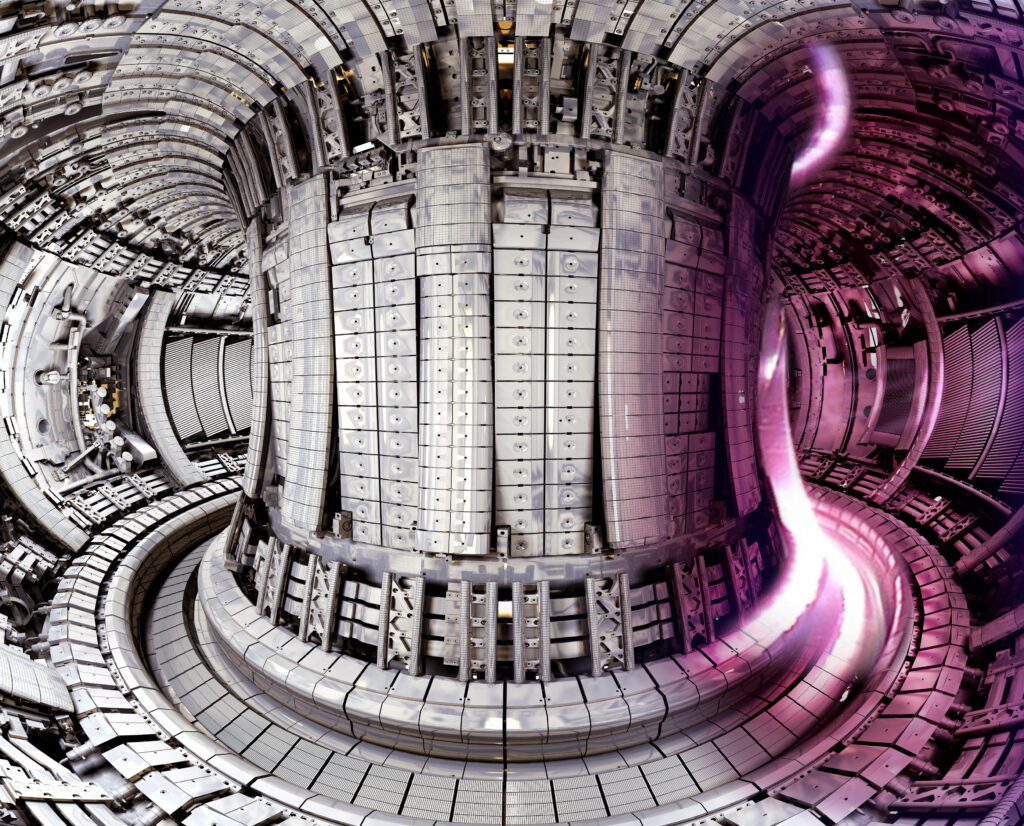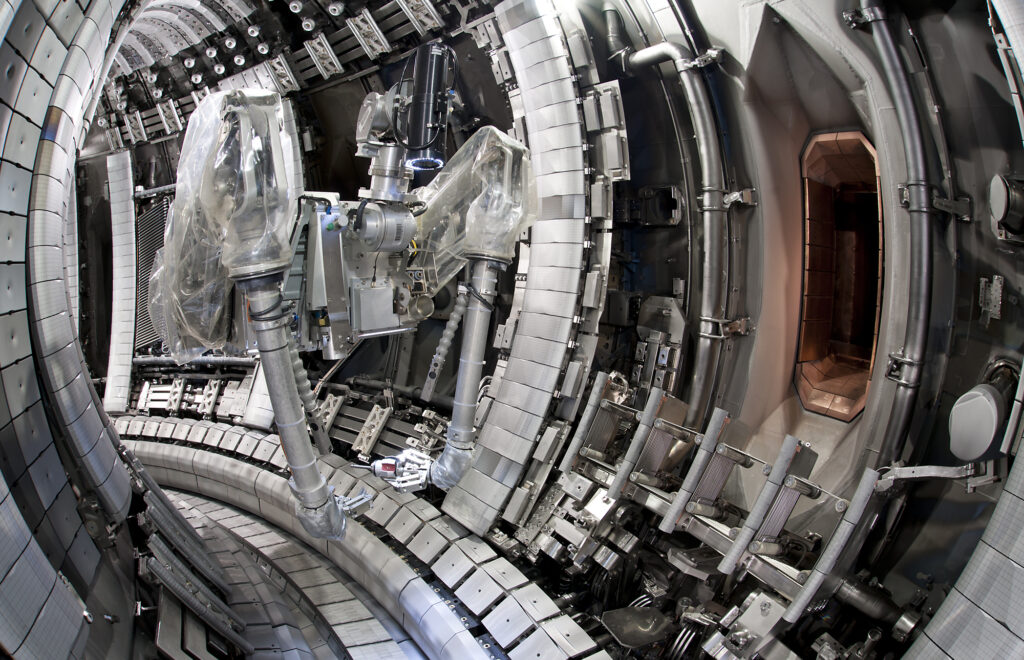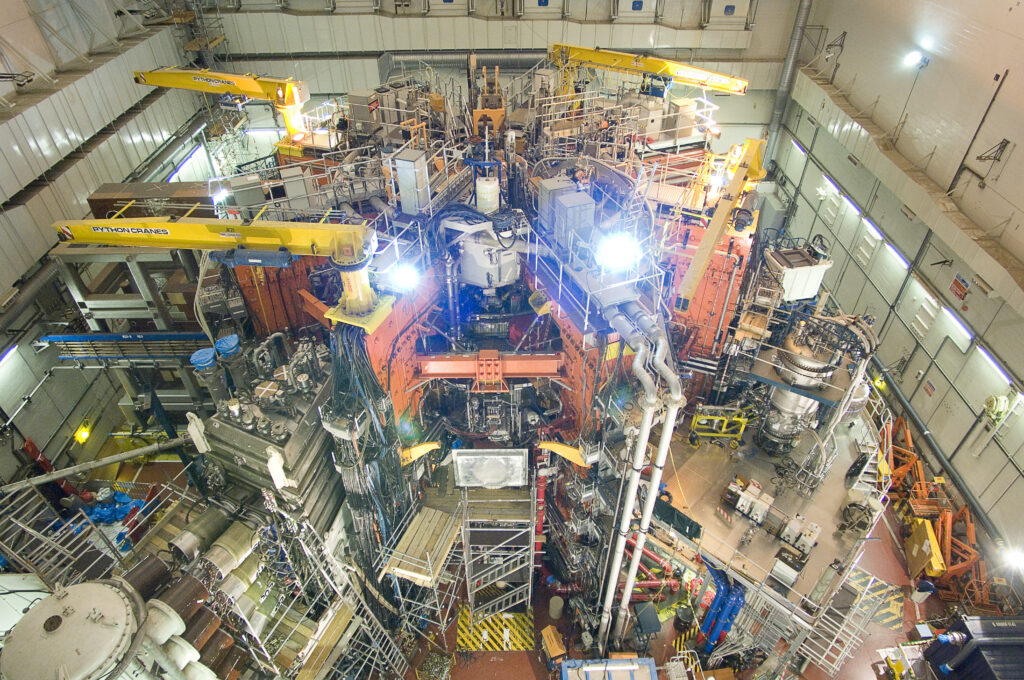The JET tokamak,as this type of donut-shaped fusion device is called, saw Deuterium-Tritium (D-T) fusion for the first time in 1997. These two atoms are heavier variants of hydrogen, which together offer the easiest, best performance for fusion energy production. In the second half of 2021, JET executed new deuterium-tritium fusion experiments for the first time in two decades.
Upgrades
Although D-T is the fuel mix of choice for both ITER and future fusion power plants, the experiments are unique set of experiments, because JET is currently the only fusion device of its kind capable of experimenting with this fuel. That makes it an ideal facility to test models for operating the plasma shots in the future fusion experiment ITER and warranted extensive upgrades to bring JET’s configuration as close to ITER as possible.
ITER is the large international fusion experiment is being built in Cadarache, France and will be the first of its kind that will produce more heat from fusion reactions than needed to keep its reaction going.
Hard to clean out deposited hydrocarbons
By far the most significant upgrade to JET was the ITER Like Wall (ILW), replacing JET’s carbon inner wall with one made of the metals beryllium and tungsten, says Guy Matthews, who was ILW project leader.
‘Carbon is very heat resistant and can’t melt’, explains Matthews, ‘but you don’t have to be much of a chemist to realise that hydrogen plasma in contact with a carbon surface will make chemistry happen, and you will get hydrocarbons.’
These hydrocarbons out of hydrogen from the plasma and carbon from the walls get deposited as gunk in remote corners of the machine, where it’s hard to clean them out. And that is a problem, especially when the radioactive fuel component tritium (an isotope of hydrogen with almost the same chemistry) ends up getting captured in the hydrocarbons. For this reason, the ITER wall is planned to be made of the metals beryllium and tungsten, which promise much lower tritium retention.
To test this new inner wall before ITER started its experiments, the ITER Like Wall was built in JET. This lead to surprising discoveries. ‘Even though it was only the tokamak wall that changed’, says Matthews, ’the physics of the plasma itself changed quite a lot. Nobody had expected that.’ For instance, it became harder to achieve high plasma temperatures, and JET physicists had to develop new ways to achieve high fusion performance.
Liquid metal flowing vertically up the wall
Also, even though beryllium and tungsten have high melting points, they can melt. ‘We had some beryllium melt damage on the inner wall early on, before we learned how to avoid it. Liquid metal flowed vertically up the wall, because of strong magnetic fields and currents’, says Matthews.
Post-1997 improvements to JET include a protection system from melt damage: near-infrared cameras that monitor the wall temperature. Since cameras looking straight into the tokamak would be blinded by neutrons, an intricate 40 m long optical relay system was built, which uses mirrors to guide the images through the 3.5 meter thick shield wall. ‘This was really necessary now, because the new wall can melt whereas the carbon wall could not,’ says Matthews. To cool the plasma quickly and protect the new inner wall from high energy disruptions, physicists developed the Massive Gas Injection system to douse the flare-up with cool hydrogen gas.
Shooting hot hydrogen into the plasma
Another big-ticket improvement to JET was on the Neutral Beam Heating system. The plasma is heated using radio waves and by injecting fast hydrogen atoms. The power of this last Neutral Beam Heating System was increased, and one of the systems was converted to inject tritium nuclei, says Joe Milnes, JET Operating Contract Senior Manager, who oversees operations and ensures the experiment is available to the EUROfusion scientific teams.
‘One of the biggest things we also had to do was to make sure our active gas handling system was refurbished’, says Milnes. The Active Gas Handling System is a processing facility for storing , purifying, delivering and recovering tritium (the active gas since it’s radioactive). ‘It was actually built for the first DT campaign in 1997, but most of that system had been mothballed since that time.’
Some improvements aren’t in hardware
Other improvements include new or upgraded diagnostics of the neutrons produced in the fusion reactions, and a system measuring conditions in the edge of the plasma. Newly developed are the tritium injection modules (TIM), which inject the tritium fuel via multiple locations into the tokamak.
Some improvements aren’t even in hardware, says Milnes. The DTE2-campaign produces large numbers of neutrons. ‘Because of that, large parts of JET become inaccessible, so we’ve had to completely rewrite the safety procedures.’ This also means retraining the -up to 500- personnel, and widening the scope of safety systems like keys, sensors and interlocks on many of the access systems.
Even though many JET personnel can’t come to the control room due to covid restrictions, there is a real sense of anticipation about the historic DTE2 experiments, says Milnes, ‘It’s a very exciting time to work on JET.’



